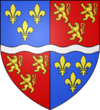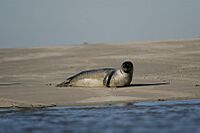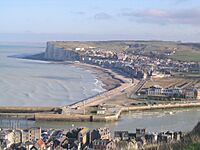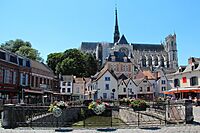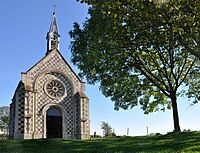Somme (department) facts for kids
Quick facts for kids
Somme
|
|||
|---|---|---|---|

Prefecture building of the Somme department, in Amiens
|
|||
|
|||
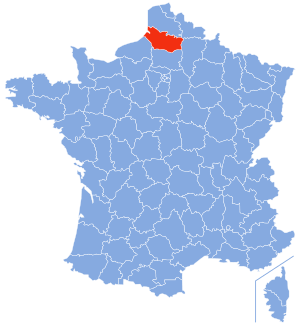
Location of Somme in France
|
|||
| Country | France | ||
| Region | Hauts-de-France | ||
| Prefecture | Amiens | ||
| Subprefectures | Abbeville Montdidier Péronne |
||
| Area | |||
| • Total | 6,170 km2 (2,380 sq mi) | ||
| Population
(2021)
|
|||
| • Total | 566,252 | ||
| • Rank | 44th | ||
| • Density | 91.78/km2 (237.70/sq mi) | ||
| Time zone | UTC+1 (CET) | ||
| • Summer (DST) | UTC+2 (CEST) | ||
| ISO 3166 code | FR-80 | ||
| Department number | 80 | ||
| Arrondissements | 4 | ||
| Cantons | 23 | ||
| Communes | 772 | ||
| French Land Register data, which exclude estuaries, and lakes, ponds, and glaciers larger than 1 km2 | |||
Somme ( Picard: Sonme) is a special area in France. It's called a department. You can find it in the northern part of the country.
The department gets its name from the Somme River. It is part of the Hauts-de-France region. Somme is surrounded by other departments like Pas-de-Calais and Nord to the north. To the east is Aisne, and to the south is Oise. Seine-Maritime is to the southwest.
On its northwest side, Somme has a coastline along the English Channel. This means it shares sea borders with Kent and East Sussex in the United Kingdom. In 2019, about 570,559 people lived here.
The central part of Somme was a very important place during World War I. Many battles happened here, including the famous Battle of the Somme in 1916. Because of these battles, you can find many military cemeteries and monuments. They honor the soldiers from different countries who lost their lives.
Another big battle, the 1346 Battle of Crécy, also took place in this department. This was a major English victory early in the Hundred Years' War.
Contents
History of Somme
The name "Somme" likely comes from an old Gaulish word, Sumena. This tells us about the ancient roots of the area.
Geography of Somme
The Somme department is located in the Hauts-de-France region. It is surrounded by several other departments. These include Pas-de-Calais, Nord, Aisne, Oise, and Seine-Maritime.
To the northwest, Somme has a beautiful coast along the English Channel. The main river flowing through the department is the Somme River. It has smaller rivers that flow into it, like the Avre, Ancre, and Noye. Other important rivers are the Authie and the Bresle.
Major Towns in Somme
The biggest town in Somme is Amiens. This city is the prefecture, which means it's the main administrative center. As of 2019, there are nine towns in Somme with more than 5,000 people living in them.
| Commune | Population (2019) |
|---|---|
| Amiens | 134,706 |
| Abbeville | 22,980 |
| Albert | 9,779 |
| Péronne | 7,577 |
| Corbie | 6,292 |
| Montdidier | 6,113 |
| Doullens | 5,890 |
| Longueau | 5,765 |
| Roye | 5,693 |
The Battles of the Somme
The Somme region played a huge role in World War I.
Early Battles of World War I
When World War I began, the Somme became a battleground. In September and November 1914, the "Race to the Sea" happened. This led to the Battle of Albert. This battle lasted five days, from September 25 to 29. The French Tenth Army attacked near Albert, trying to push towards Bapaume. The German Sixth Army fought back towards Albert. The front lines eventually settled around the town of Thiepval. They stayed there until July 1916.
The Main Battle of the Somme (1916)
The Battle of the Somme in 1916 was one of the most costly battles of World War I. Allied forces tried to break through German lines. This happened along a 40-kilometer front, both north and south of the River Somme.
The Allies had planned this as one of several big attacks in 1916. However, Germany attacked first at the Battle of Verdun. As that battle continued, the goal for the Somme campaign changed. It was no longer just about defeating Germany. It became about drawing German forces away from Verdun. This would help the Allied forces fighting there. By the end, more soldiers were lost at the Somme than at Verdun.
While Verdun was very important for France, the Somme had a similar impact on Britain. The first day of the battle, July 1, 1916, is especially remembered. On this day, the British suffered 57,420 casualties, with 19,240 deaths. This was the bloodiest day in the history of the British Army. The battle was terrible for all soldiers involved, not just the British. By the end, the British learned a lot about modern warfare. The Germans also suffered huge losses that were hard to replace.
Historian Sir James Edmonds said that the Somme offensive in 1916 helped set the stage for the final victory on the Western Front.
Impact on the Home Front
For the first time, people back home in Britain saw the horrors of modern war. This happened through a propaganda film called The Battle of the Somme. This film used real footage from the first days of the battle.
Later Battles
The Somme region saw war two more times in 1918. These were the First and Second Battles of the Somme.
Population Changes in Somme
The population of Somme has changed over many years. Here's how it has grown and shrunk since 1801:
| Historical population | |||||||||||||||||||||||||||||||||||||||||||||||||||||||||||||||||||||||||||||||||||||
|---|---|---|---|---|---|---|---|---|---|---|---|---|---|---|---|---|---|---|---|---|---|---|---|---|---|---|---|---|---|---|---|---|---|---|---|---|---|---|---|---|---|---|---|---|---|---|---|---|---|---|---|---|---|---|---|---|---|---|---|---|---|---|---|---|---|---|---|---|---|---|---|---|---|---|---|---|---|---|---|---|---|---|---|---|---|
|
|
||||||||||||||||||||||||||||||||||||||||||||||||||||||||||||||||||||||||||||||||||||
| Sources: | |||||||||||||||||||||||||||||||||||||||||||||||||||||||||||||||||||||||||||||||||||||
Tourism and Sights
The Somme department offers many interesting places to visit. You can explore its natural beauty and historical sites.
Image gallery
-
Seal in the bay of Somme
-
View of Mers-les-Bains
-
Chapel in Saint-Valery-sur-Somme
More About Somme
- Cantons of the Somme department
- Communes of the Somme department
- Arrondissements of the Somme department
See also
 In Spanish: Somme (departamento) para niños
In Spanish: Somme (departamento) para niños



